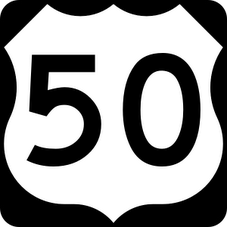ROUTE 50 ASSOCIATION MEETING
MAY 19, 2004
POLISH PINES RESTAURANT, KEYSER, WV
County Commissioner Cindy Pyles opened the meeting by welcoming attendees to Mineral County. She noted that the group’s efforts to improve U.S. Route 50 is extremely important to supporting economic growth IN THE REGION.
Dr. Wayne Spiggle reviewed the minutes of the March 17, 2004 meeting noting some of the comments received from the counties regarding needed improvements within their respective jurisdictions. The following items from the prior meeting were also discussed.
• Communication from Bill Wood, WVDOH, indicating that DOH would begin collecting information on road and bridge conditions, traffic counts and accident information in an effort to prepare a study of needs on Route 50 from I-79 east to the Virginia state line. Comments and concerns generated through this Association would be incorporated into the study. The report is expected to take up to one year to complete.
• Memorandum of Understanding A draft memorandum of understanding was given to each county commission. The memorandum sets forth the purpose of the Association and establishes the mechanism for each commission to officially recognize and participate in its activities. Any changes to wording should be provided to Michael Bland, Mineral County Coordinator.
• Naming of U.S. Route 50 Discussion indicated the most likely name would either be the George Washington Highway or Northwestern Turnpike. No final consensus was obtained.
Dr. Spiggle welcomed Richard Hartman and Mike White, WVDOH, who would participate later in the meeting.
• Designation is requested by the local group based on the intrinsic qualities of the route being promoted (i.e. historic, cultural, scenic, recreational, etc.). The naming of the by-way would normally be tied to the identified qualities.
Funds may be used for signage, scenic easements, scenic pull-offs and management. Funds are not used for general road improvements or maintenance.
• Designation does not help or hurt monies available for maintenance.
• Designation prevents any additional roadside signage for commercial advertisement and business. Businesses along the route would be restricted to a sign at their place of business.
• By-way projects approved last year have not yet been funded.
• Designated by-way name does not impact 911 or local addressing.
• Advised that the Route 50 Association needed to develop a unified strategy and speak as a single group.
Frank O’Hara, Mineral County, made a brief presentation on existing accident data and safety concerns on Route 50. Statistics included factors related to the accident including driver age, weather conditions, time of day and location. Mineral County has the highest mortality rate in the State based on percentage of accidents and Hampshire County is 5th.
David Moe, Garrett County, Update on North-South Corridor Study In fiscal year 2003, Congress appropriated $2 million to study the U.S. Route 220 corridor. The purpose of the study was to develop a recommended north/south connection between I-68 in Maryland and Corridor H in West Virginia. Initial funding provided $1.5 million to West Virginia and $0.5 million to Maryland. Congress appropriated an additional $1 million for Maryland in fiscal year 2004, however those funds have not fully authorized.
A memorandum of understanding outlining the conditions and parameters for the study has been prepared and approved by West Virginia.
Maryland has not approved the memorandum to date. A meeting between West Virginia and Maryland to include discussion of the memo is scheduled for May 26, 2004.
Once a route is determined, an additional factor will be the construction standards for the highway. The four-lane would either be built to Appalachian Highway Standards or Interstate Standards. The Interstate Designation would be important to economic development for its significance to industry looking for new sites.
Dr Spiggle concluded the meeting with discussion on the following:
• Route 50 Association Is intended to be a partnership with DOH in promoting improvements to the route.
• Deb Clatterbuck will chair a committee on whether by-way designation should be pursued for U.S. Route 50. Persons interested in participating in those discussions should contact her.
The next meeting is scheduled for July 21`, 2004 at the Penn Alps Restaurant, Grantsville, Maryland. Lunch at 12:00 noon, followed by the business meeting at 1:00 PM.

No comments:
Post a Comment